
World
Intimate Moments Reveal Migrants' 1000-Mile Trek Across Balkans
Photographer Marko Drobnjakovic used Instagram to capture migrants crossing the Balkans seeking refuge from the war-torn Middle East.
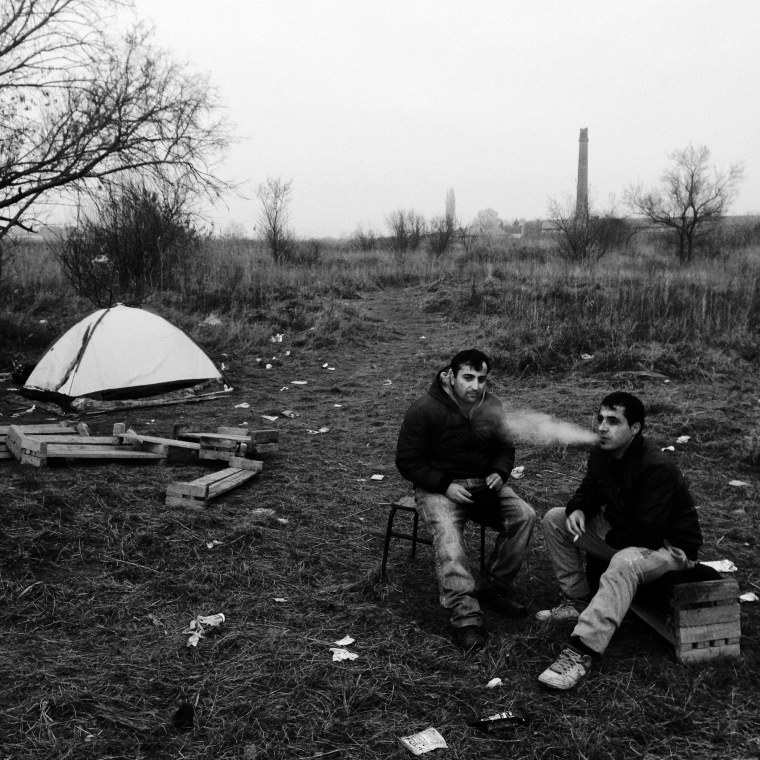
It began as a slow trickle in late 2014, a few dozen migrants at a time surreptitiously crossing the Balkans hoping to reach Europe. Photographer Marko Drobnjakovic caught wind of their journey early on, noticing an increase of Middle Eastern guests at a Belgrade hostel across from his home. Over the next several months, he witnessed the trickle transform into a full-on crisis.
Above: Two men from Iraqi Kurdistan rest close to an abandoned brick factory that many migrants and refugees used as shelter in Subotica, Serbia on Dec. 15, 2014.

Left: Dule, a Serbian man, pets a stray dog in Subotica on Feb. 12, 2015. He often provides migrants with food and lodging as they pass his abandoned brick factory in Subotica, close to the Serbian border with Hungary.
Center: Refugees from Kobani, Syria rest in a field in Presevo, Serbia on June 22, 2015. Presevo is the point of entry into Serbia from Macedonia.
Right: An Afghan man stands in a campsite where he and his friends will rest in Subotica, Serbia on Feb. 22, 2015.
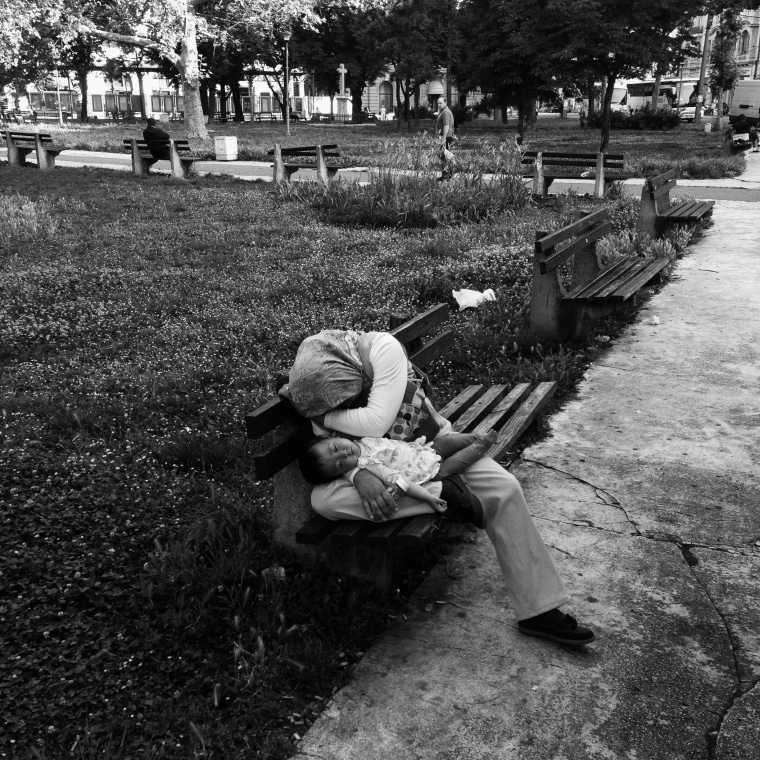
Last year, more than 1 million migrants crossed the Mediterranean. Their treacherous journey through the Balkans begins on the shores of Greece and ends in Austria, taking about two to three weeks to cover over 1,300 miles. Drobnjakovic joined the migrants on various stretches of their trip, communicating with Arabic phrases he picked up along the way.
Above: An afghan woman holds a baby in her arms as they sleep on a bench in a park in Belgrade, Serbia on June 12, 2015. Many migrants lacked funds to stay in hotels and would often sleep in Belgrade parks on their journey.
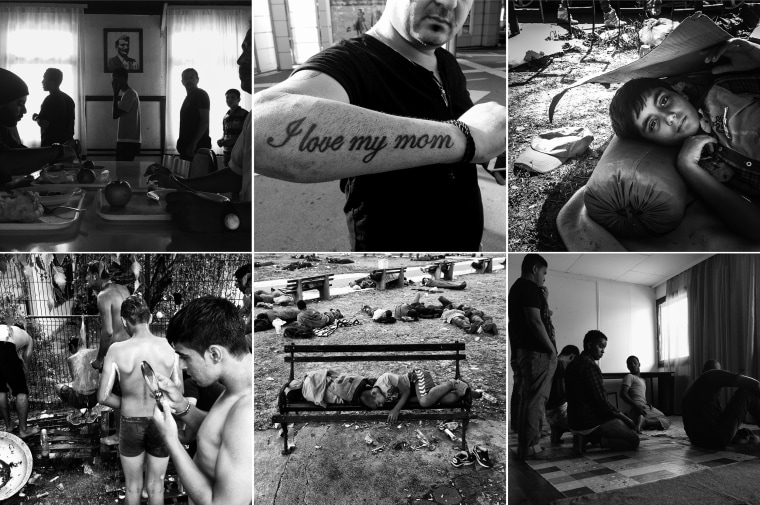
Top, left: Migrants eat a meal at a refugee camp on the outskirts of Belgrade, Serbia on June 4, 2015. Refugee camps inside Serbia provide migrants with basic accommodations, including clean beds, running water and three meals a day.
Top, center: An Iraqi migrant shows the tattoo on his arm at a bus terminal in Belgrade, Serbia on June 12, 2015.
Top, right: A boy from Syria hides from the summer sun underneath a piece of cardboard at a park in Belgrade, Serbia on Aug. 26, 2015.
Bottom, left: Refugees from Afghanistan wait in line to shower in cold water in Subotica, Serbia on July 27, 2015.
Bottom, center: Children sleep on a park bench in Belgrade, Serbia on July 21, 2015.
Bottom, right: People pray inside a migrant camp on the outskirts of Belgrade, Serbia on June 4, 2015.
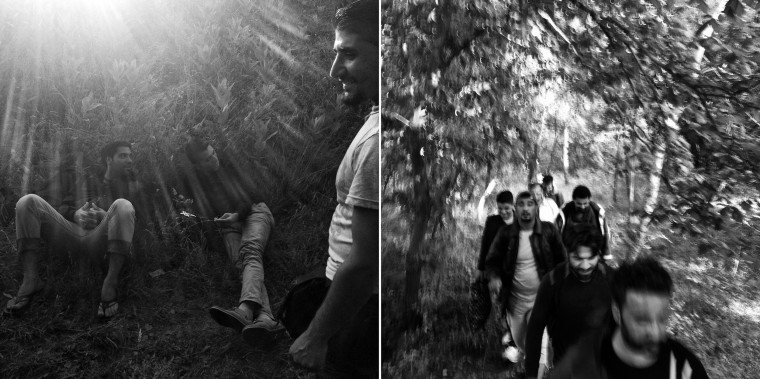
Left: Syrians rest before attempting to cross into Hungary under the cover of darkness from Martonos, Serbia on May 29, 2015.
Right: Migrants hike through a forest in Martonos on May 29, 2015. The group crossed the Serbia-Hungary border a few hours later, avoided detection and safely made it to Vienna, Austria before continuing to Germany.
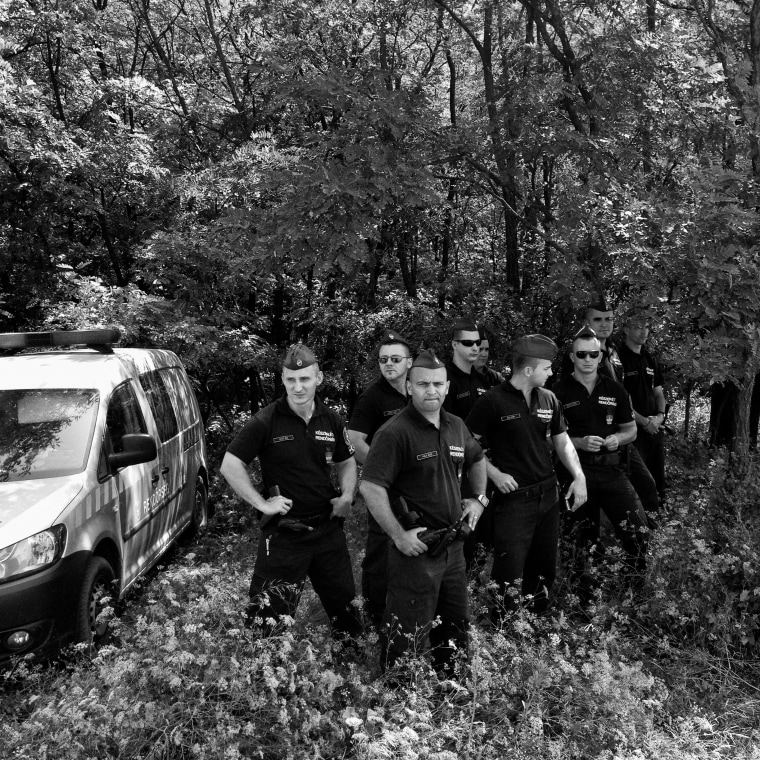
As Drobnjakovic chronicled their movements with his professional camera, he would catch in-between moments with his phone, regularly posting to Instagram. Mobile phones are a familiar tool for the migrants, a lifeline to family they've left behind or are trying to reach. With his phone, Drobnjakovic was able to catch quiet scenes unobtrusively.
Above: Hungarian police patrol a forest close to the country's border with Serbia in Morahalom, Hungary on June 16, 2015. As the numbers of migrants increased over the summer, Hungarian authorities imposed stricter controls and deployed more personnel to the area in an attempt to stem the flow of people to their territory.
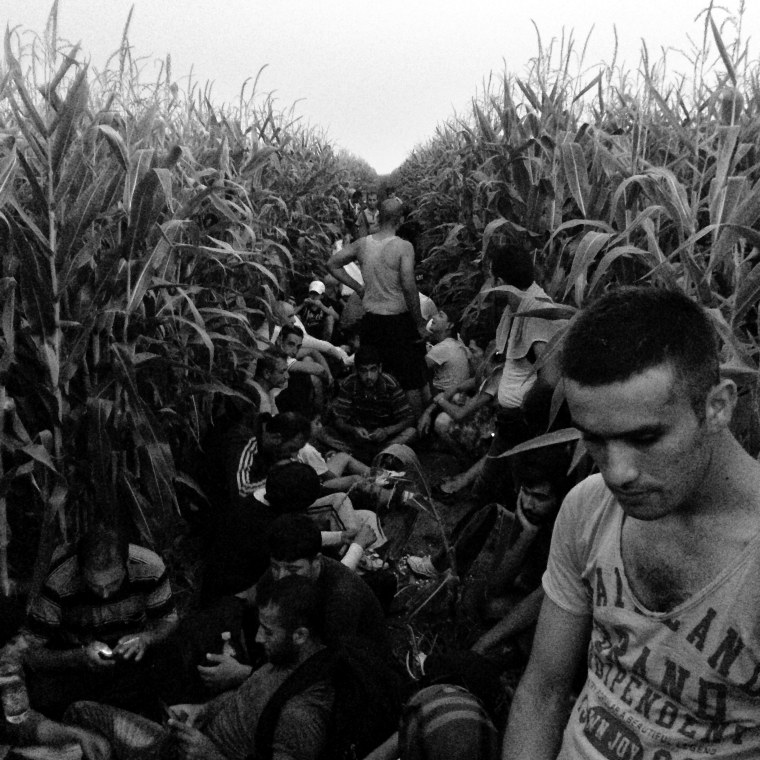
What started as discreet trek of a few people hiking through forests, turned into chaotic scenes over the summer as thousands of migrants flooded the routes and countries scrambled to tighten border restrictions. By the end of the summer, Hungary — the entry point into Europe's passport-free Schengen Area — had erected a razor wire fence along its 109-mile border with Serbia, diverting migrants to Croatia and Slovenia and adding days on to their journeys.
Above: A group of Syrians hide in a corn field feet away from Serbia's border with Hungary in Horgos, Serbia, on August 11, 2015. The group hid for hours waiting for the sun to set, then crossed the border at dusk only to get caught by the Hungarian authorities. After spending several days in detention, they were released and continued their journey, eventually reaching Germany.


As refugee immigration policies were debated by European countries, migrants were often stranded at closed borders, train stations and camps with thousands more arriving each day. While Macedonia and Serbia had initially allowed migrants to pass freely through their countries, in November, they began to restrict entry to only those coming from Syria, Iraq or Afghanistan.
Above: An Iraqi Kurdish mother pauses with her children as they crossed from Serbia into Hungary in Roszke, Hungary on Sept. 3, 2015.

Left: People follow train tracks that lead from Serbia to Hungary in Horgos, Serbia on Aug. 29, 2015.
Center: A Hungarian police officer stands guard as a train carrying hundreds of migrants is prevented from going to Austria from Bicske, Hungary on Sept. 3, 2015. In September, Hungarian authorities banned migrants from boarding trains to destinations in Western Europe.
Right: People rejoice as they boarded a bus that would take them to Hungary's border with Austria from Budapest, Hungary on Sept. 5, 2015.
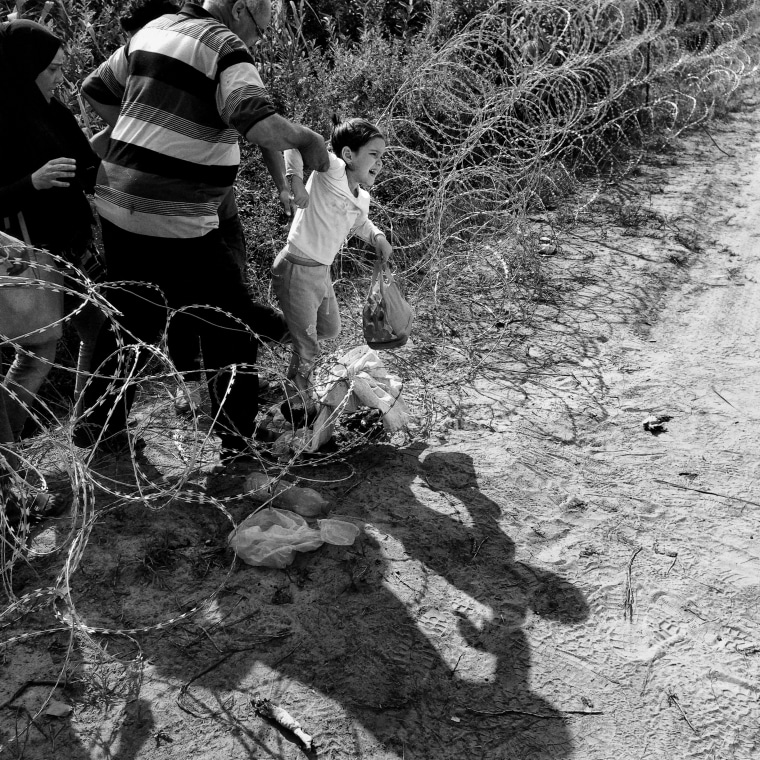
A man lifts a child over a section of Hungary's border fence in Roszke, Hungary on Sept. 3, 2015. Before Hungary sealed off its border with Serbia, migrants often jumped over the fence in order to avoid registration and fingerprinting by the Hungarian police for fear of deportation.
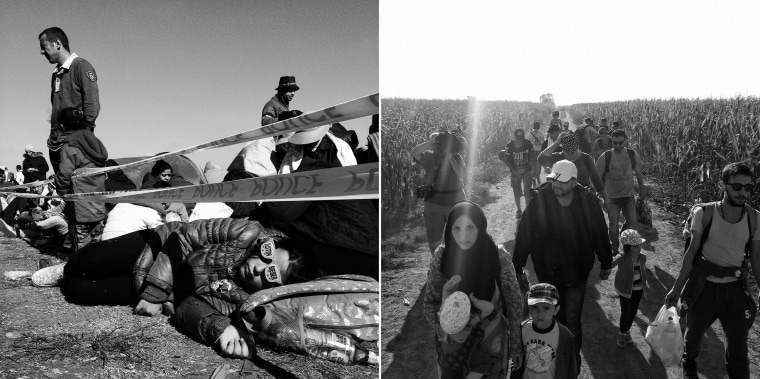
Left: A girl from Syria sleeps in a field in Roszke, Hungary on Sept. 8, 2015. Bottlenecks at the border caused many to wait for days in fields before being allowed to continue their journey.
Right: Refugees walk through a corn field in order to reach Serbia's border with Croatia in Sid, Serbia on Sept. 18, 2015. Lack of communication between Serbia and Croatia resulted in migrants often stranded in corn fields and unofficial border crossings, sleeping out in the open, with little food and water.

Having waving atched the crisis unfold, Drobnjakovic recognizes that improvements have been made on the route, making the journey through the Balkans a little safer and smoother for migrants travelling today. There is now transportation as they enter Serbia, taking them directly to the border with Croatia, with similar options available as they continue. Few people now face sleeping in the park in Belgrade.
Above: A boy cries out as he is separated from his family in Tovarnik, Croatia on Sept. 17, 2015. Migrants tried to board to Hungary or Slovenia, but the high volume of people that converged at the local train station in Tovarnik often meant that not everyone could board. After Hungary sealed its border with Serbia, Croatia struggled to cope with the new influx of thousands transiting through its territory.

Left: People warm themselves with blankets as they wait outside a registration camp for migrants in Opatovac, Croatia on Sept. 25, 2015. The Opatovac camp was formed by the Croatian officials to quickly and effectively register people before they continued on their route.
Center: Migrants wait before to enter Croatia in Berkasovo, Serbia on Oct. 23, 2015.
Right: A photograph of a child sits in a pile of trash at a border crossing between Serbia and Croatia in Berkasovo, Serbia on Oct. 25, 2015.

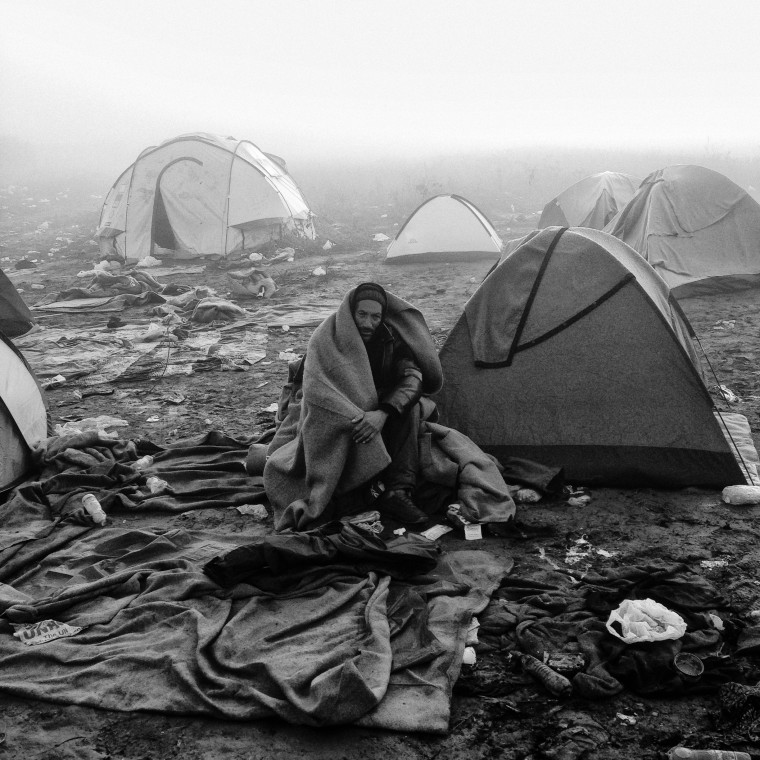
Having waving atched the crisis unfold, Drobnjakovic recognizes that improvements have been made on the route, making the journey through the Balkans a little safer for migrants travelling today. There is now transportation as they enter Serbia, taking them directly to the border with Croatia, with similar options available as they continue. Few people now face sleeping in the park in Belgrade.
Above: A man wrapped in a blanket rests close to a border crossing in Berkasovo, Serbia on Oct. 24, 2015.
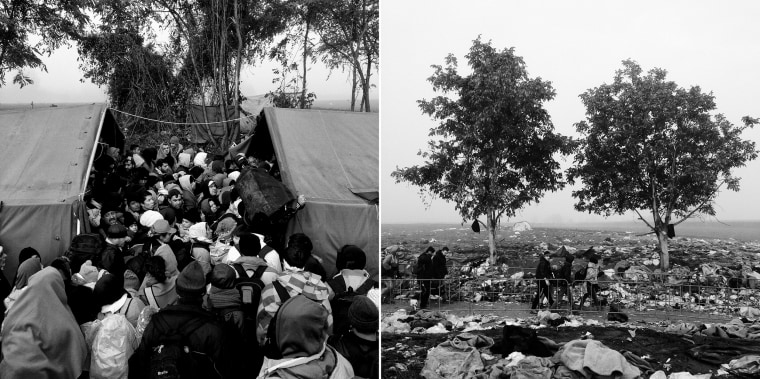
Left: People push and shove as they try cross Serbia's border with Croatia in Berkasovo, Serbia on Oct. 24, 2015. Crossings on the Serbian side of the border with Croatia were not policed or controlled. People that were exhausted, hungry and thirsty were left to their own devices, which at times resulted in scenes of chaos, with scuffles and shoving breaking out on a daily basis.
Right: People walk through piles of garbage as they cross from Serbia into Croatia in Berkasovo, Serbia on Oct. 24, 2015.
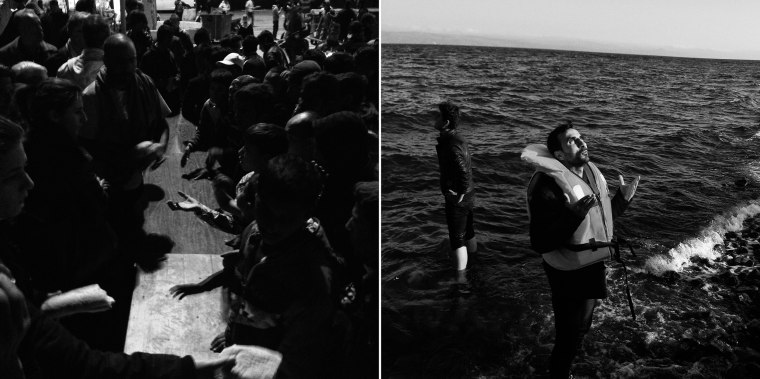
Left: A boy extends his hand as food packages are distributed to migrants in the port of Mytilene on the Greek island of Lesbos on Nov. 2, 2015. Non-government agencies and volunteer groups provide vital aid and logistics to people that have made the crossing from Turkey to Greece.
Right: A man prays after arriving safely at a beach on the northern shore of Lesbos, Greece on Nov. 7, 2015.
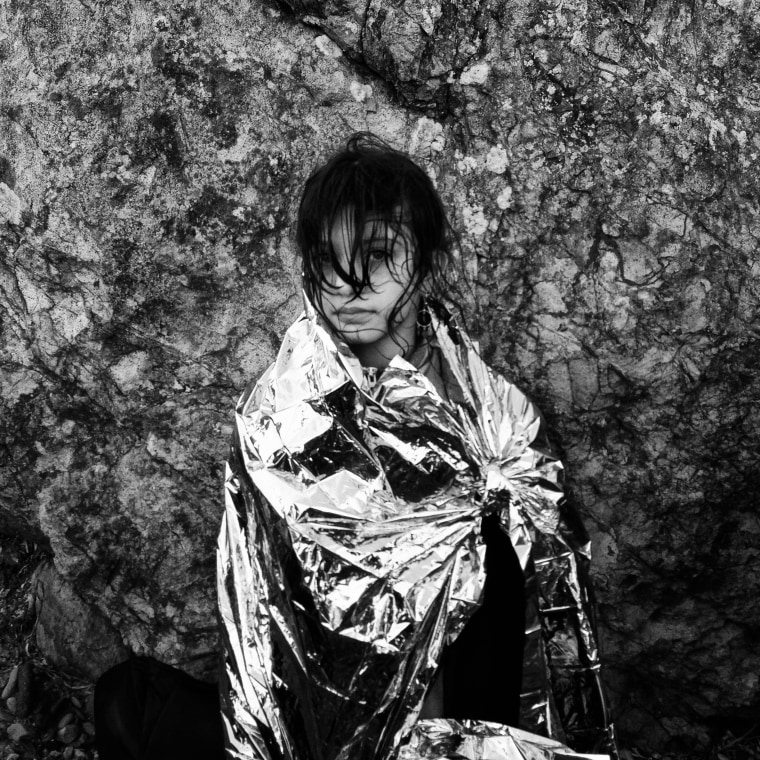
But more challenges remain ahead. As migrants continue to risk their lives crossing the Aegean in rough winter weather, those not from Syria, Afghanistan, or Iraq remain stranded in Greece. Not allowed to continue on their journey, migrants face seeking asylum in a country with a fragile economy and 25 percent unemployment or registering for voluntary repatriation after having spent their savings to get to Europe.
Above: A girl wrapped in a thermal blanket stands at a beach on the northern shore of Lesbos, Greece on Oct. 31, 2015.

Left: A family waits to board a ferry to Athens in the port of Mytilene, on the Greek Island of Lesbos on Nov. 6, 2015.
Center: A woman is helped off a boat that carried her and her family from Turkey to Lesbos, Greece on Nov. 7, 2015.
Right: The body of a woman is washed ashore at a beach in Lesbos, Greece on Nov. 1, 2015. The risky journey across the Mediterranean in overcrowded dinghies is estimated to have caused almost 3,800 deaths from drowning in 2015.
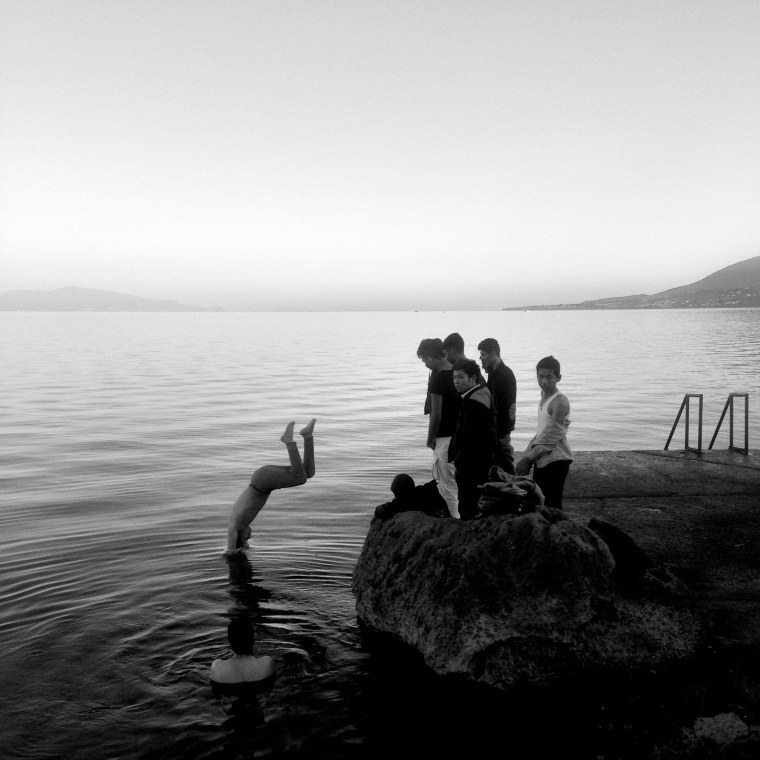
An Afghan man jumps into the Aegean at the port of Mytilene on the island of Lesbos, Greece on Nov. 4, 2015. After arriving in Lesbos and registering at migrant camps, thousands of people converge on the commercial port of Mytilene, where they board ferries bound for Athens to continue their journey.
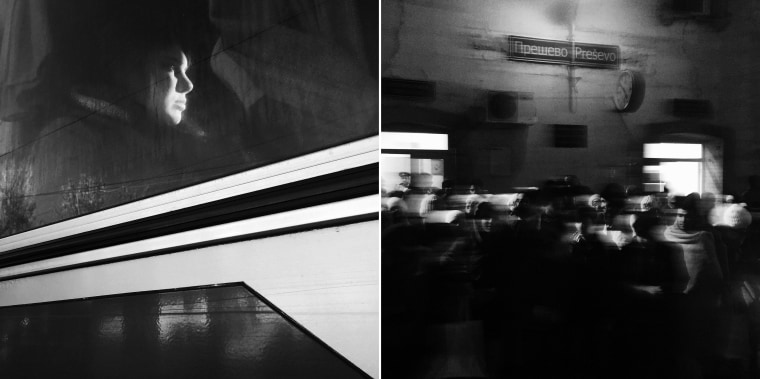
Left: Zahra, 17, a refugee from Afghanistan, sits inside a bus going to Serbia's border with Croatia in Presevo, Serbia on Dec. 23, 2015.
Right: People crowd a railway station as they wait for a train that would transport them further north in Presevo, Serbia on Dec. 23, 2015.
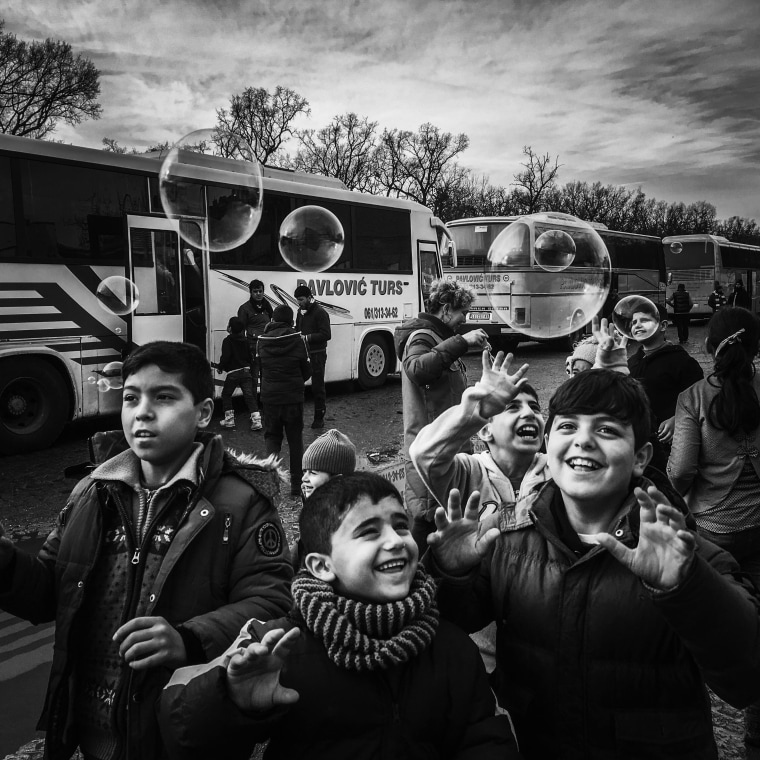
As the conflict in the Middle East continues with no end in sight, so does the flood of migrants hoping for a better, safer life for their families. And Drobnjakovic continues to photograph the biggest migrant exodus since World War II.
Follow Marko Drobnjakovic or see his series on Instagram.
Above: Children chase soap bubbles while they and their families wait for transportation outside a refugee center in Adasevci, Serbia, close to the country's border with Croatia, on Jan. 11, 2016.